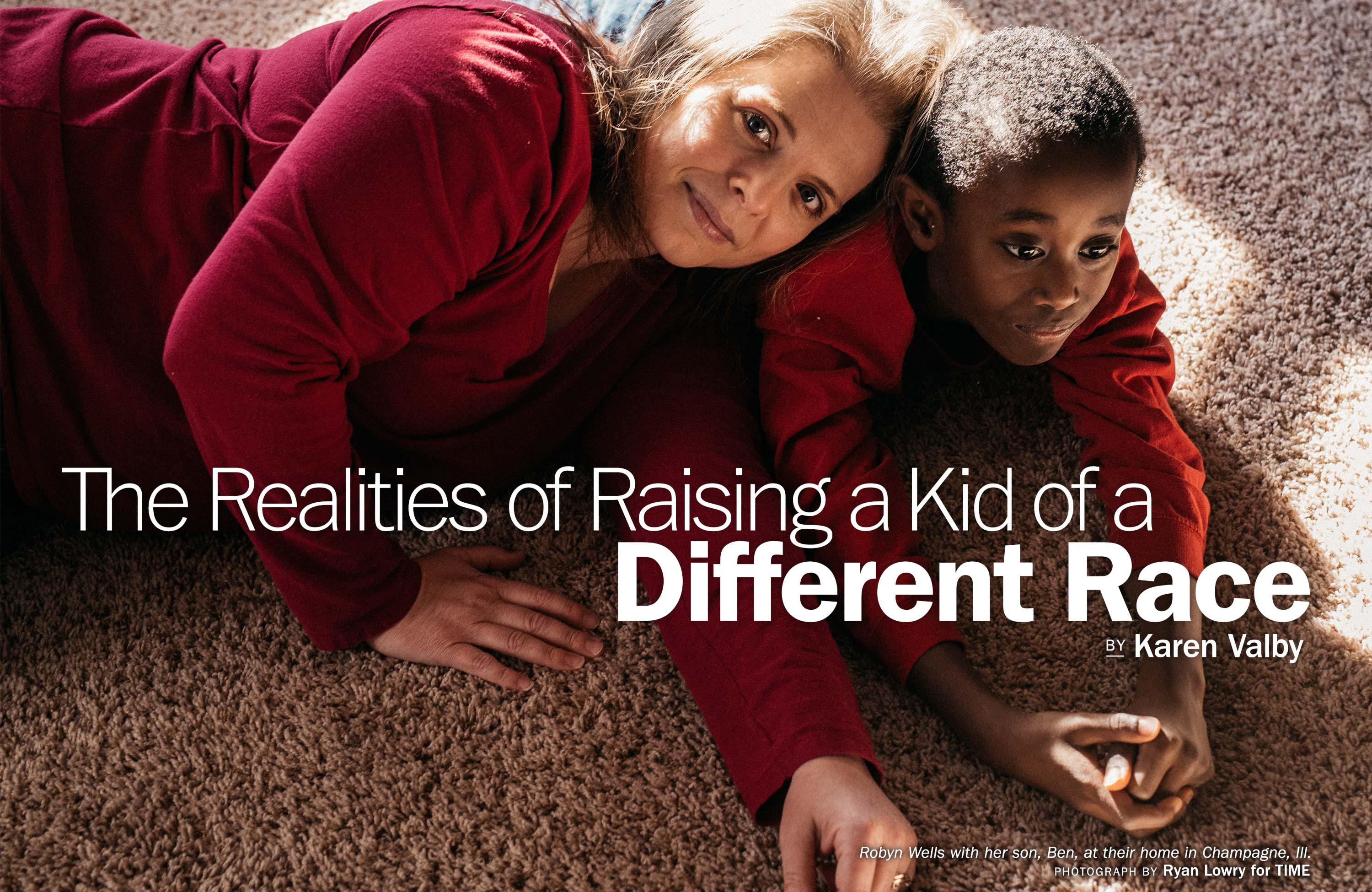As transracial adoption becomes more common, here’s what every parent should know
Karen Valby is a writer who lives in Austin, Texas. She and her husband, who are white, have two adopted daughters, one Ethiopian and one African- American.
Robyn Wells believed she went into the adoption of her Ethiopian son with eyes wide open. She and her husband Timothy, a police officer and Army veteran, who served two tours in Iraq and one in Afghanistan, brought Ben home when he was four years old. The Wells are white and live in Champaign, Illinois, a multi-cultural Big Ten university town and have gone to some effort to create a diverse environment for their son and three biological daughters. Wells knew that raising a black son wouldn’t always be easy. “I figured I’d have to explain some name-calling, have hard talks about language, navigate the waters when somebody’s parent won’t let my son take their daughter to prom,” she says. “But what I have been surprised by is this: At no point in the process of considering transracial adoption did I think I would have to teach my son how to stay alive.”
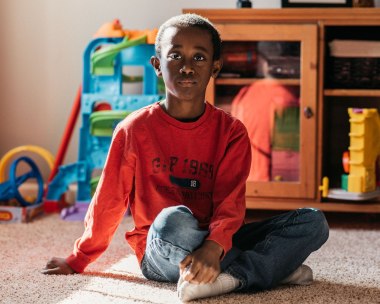
First, she says of her awakening, there was the shooting of Trayvon Martin in 2012. At the time Ben was a 6-year-old boy who had just learned to ride his bike after only two trips up and down the driveway with his father running alongside him. “It was awful,” says Wells, “but I thought—as every white privileged parent wants to think—maybe this is an isolated incident.” As events quickly proved, it was not.
Many families struggle with the question Wells is facing: how do white adoptive parents help their children of color thrive? Today, more than 40% of adoptions are transracial in nature according to a recent survey from the Department of Health and Human Services. This is up from 28% in 2004. Transracial adoption has become a common enough sight in celebrity tabloids that since my husband and I adopted our two daughters (a 1-year old Ethiopian in 2009 and a newborn African-American last October), we have endured many unfunny jokes about being on trend.
In our own adoption training I mostly remember sitting in our agency’s room with other prospective white parents nibbling on fruit and cheese, listening to white people talk about race. The main takeaways were either aesthetic in nature, about the practicalities of black hair and skin care, or hopelessly broad.
On the advice of an African American friend Wells has chosen to start having some hard conversations with her now 8-year-old son Ben, even though she does it in the car so that he doesn’t have to see her tears. Her insistence on these talks has created friction with her police officer husband, Timothy who explained by email that his job as Ben’s father is “to raise Ben to be a good man… The other part of my job is to balance my wife’s education. I don’t want Ben to ever be afraid of police or to ask for their help.”
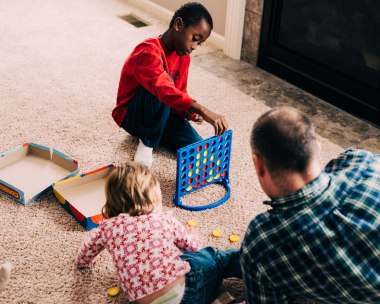
So what can parents do? “When I meet adoptive parents I tell them to look to my era to what didn’t work,” says Chad Goller-Sojourner, 43, a Seattle-based black author and playwright who was adopted by white parents and who is working on a book that is half memoir and half training exercises for adoptive parents. “If you imagine my parents, they were the ones who got the box of Ikea furniture with no directions in Swedish or English. Today you can get the box and have the video and step-by-step instructions in different languages.”
There tends to be a dispiriting response to stories of transracial adoption—particularly when adoptees dare share feelings of ambivalence or pain—that adoptees should be grateful, considering the alternatives. But to suggest that they should pipe down because they didn’t languish in foster care or an orphanage is to deny the idea that every child deserves the best possible home with a family who is willing and prepared to meet their needs.
In the spirit of searching for better instructions, I interviewed adoptees ranging in age from their 20s to their 50s. From my many conversations, it became clear that we adoptive parents too often choose to delude ourselves with four comforting but dangerous myths.
Myth 1: Color doesn’t matter
“Parents who believe they can raise their child color-blind are making a terrible mistake,” says Korean adoptee Mark Hagland, a 54-year-old journalist and adoption literacy advocate. “And it’s shocking how many people I meet still think this way. If there’s a single thing I can share with white adoptive parents [it’s to] look at the adult adoptees who have committed suicide, or who have substance abuse problems. Love was not enough for them.”
Part of loving your child is seeing and loving the color of her skin—and accepting the reality that she will likely be painfully pigeonholed sometime in her life because of it. Abigail Scott, 21, is a Chinese adoptee who grew up with her single mother in what she calls the bubble of Berkeley, California. Her mother did many smart things to foster her only daughter’s connection to the land of her birth. She was active in the organization Families of Children from China. She and her daughter returned to China for a two-week trip when Scott was 12. She encouraged her daughter to apply for Chinese mentorship programs at UCal, though Scott resisted because growing up she found herself increasingly disinterested in exploring her Chinese culture.

Scott says she never told herself that she wanted to be white, but always felt atypically Chinese. She was a muscular lacrosse player who loved being tan. She told her mother never to buy her anything Hello Kitty. She’s only attracted to white boys and the majority of her friends were white. When she and her mother went to large family functions, Scott remembers noticing that everyone else in the room was white except her. “But they were all family so I didn’t feel ostracized or different,” she says.
When she announced that she’d chosen Boulder, Colorado, for college some friends expressed concern. “People told me ‘Boulder? Whoa, that’s really white,’” she says. “But I just thought ‘Oh, you see who I’ve grown up with, it’s not going to matter.”
At one of her first fraternity parties, a drunk white boy sidled up to her and asked her about her foreign exchange program. People assumed she wasn’t American, that she was a nerd, that her only concern was math homework—and Scott tumbled into a depression. “Maybe it was my insecurities,” she says. “I’m not positive everyone thought I was weird for being Asian, or wasn’t cool for not being blonde, but I couldn’t have been imagining all of it. I’d never felt so Chinese. It was the first time it became apparent to me that I’m a certain race and people have expectations around that.”
After a year of making tearful phone calls home to her heartbroken mother Scott transferred and landed more happily at Loyola Marymount in Los Angeles where she is majoring in sociology. She accepts for now that she is confusingly adrift between her American and Chinese identities.
“I think every adoptee inevitably is going to go through a period where the shock of race is real,” she says. “It can happen when you’re 8 or 13 or 28. And when you’re really depressed and feel really different you don’t want to hear love is enough. That’s b—s— because I wouldn’t be feeling like this if that were true.” The best thing Scott’s mother did, she says, was to listen to her pain, rather than dismiss her with excuses or denials, and love her through it unconditionally.
Myth 2: If I talk to my kids about race, I’m just creating an issue
When I tell Hagland, who is a co-moderator on the closed Facebook group TRA (a Transracial Adoption community comprised of adoptive parents, adult adoptees and birth parents) that many adoptive parents, including me, feel tremendous anxiety around introducing concepts of racism to their children he is kind but emphatic. “May I please nuclear bomb that for you?” he says. “It’s inevitable that your black children will be called the N word. It’s inevitable that they will be othered for being black. So if you prepare them for that you are helping them.” He’s well-used to adoptive parents’ hand-wringing, which often masks a great fear of inadequacy and powerlessness, on the subject. “Are you not going to teach your child how to cross the street?” he asks. “ ‘I could never talk about being hit by a car because then my child would fear it.’ Well guess what? Part of your role as a parent is teaching your child how to safely cross the street.”
Alex Landau, a 25-year-old from Denver, remembers his first racial encounter. He was four years old, an African-American boy scuffling with a white boy on a Denver playground. “And he said ‘Not all white kids like to play with black kids,’” remembers Landau. “I didn’t know the gravity of what he was saying, and I don’t think he even fully knew what he was saying. But I just knew that my skin was different and I had no control over that.” As Landau struggled to make sense of his hurt he remembers his white adoptive mother Patsy Hathaway careening into the picture. “My mom came out of left field, grabbed him by the arm, and said ‘You don’t talk to my son that way. You need to leave!’ and kicked him out of a public park.”
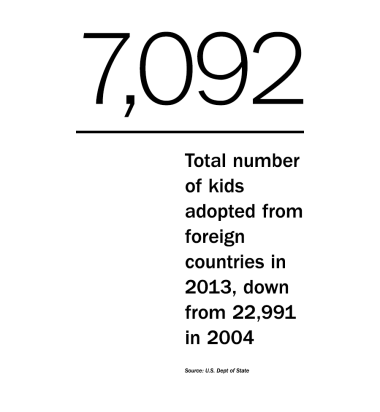
But for the most part, race was never a conversation in their home. Patsy loved her son fiercely, and didn’t think much of the fact that he was the only black kid in his high school graduating class. Meanwhile Landau spent much of his adolescence gelling his hair straight and wearing long sleeves and pants in the summer to cover up his dark skin. When he left home for college, his dad, who comes from a long line of Denver policemen, never gave him the talk—a tradition in many African-American homes—about how to have self preserving interactions with police and other authority figures. “I think my parents were under the impression that we were living in this post-racial era where police were not racially profiling,” says Landau.
In 2009 Landau, then 19, was driving in Denver with a white friend in the passenger seat. Cops pulled him over and the officer accused Landau of making an illegal left turn. Landau was hauled out of his car and patted down. “There were three officers there, I was comfortable putting my arms out to the side and asking to see a warrant before they continued searching my car,” he says. “I’m not in handcuffs, I’m not being detained, there’s nothing wrong. We should be able to talk as people. And then immediately I had my world changed.”
The officers grabbed Landau and started hitting him in the face. When he came to, his blood was all over the grass and he couldn’t see out of his right eye. “’Where’s your warrant now, you f—ing n—–?” were the first words he says he heard upon regaining consciousness. When Hathaway arrived at the city jail and saw her son’s brutalized face her world changed forever too.
Although the policemen were cleared of misconduct in an internal review (they said they thought Landau was reaching for one of the officers’ guns), in 2011 Landau was awarded a $795,000 settlement from the City of Denver. Two of the police officers who attacked him were later fired for unrelated uses of excessive force. Today Landau is the Racial Justice Organizer at the Colorado Progressive Coalition and he and his mother are working on a book about transracial adoption and the patterns and practices of police abuse in Denver. “I know my mother wishes she could have had the insight herself to prepare me for the ugly realities that can occur,” he says. “She demonstrates her sorrow and her eagerness to learn through her activism and her connection to the work I’m doing. She’s just soaking it all up like a sponge left and right.” [For tips on what she’s learned click here]
Together they hope to help spare future transracial families the ordeal of that night. “The best thing you can do is prepare your child because the last thing you want to do is visit your child in jail with 45 stitches in his face and have your whole worldview blown apart,” says Landau, who recalls the most painful part of this experience as seeing his mother crumble when she saw him in jail. “It was the first time I cried. I was just devastated. So I would strongly advise that parents do not have this sheltered mindset and be open to the narrative of folks who actually live this experience day to day.”
Myth 3: No matter what, a “good” school is the best thing for a child
You can celebrate Kwanzaa. You can learn how to twist and box braid your daughter’s hair. You can make #BlackLivesMatter your Facebook profile picture. But for many white adoptive parents, the act of raising kids in a diverse environment is too hard, or too inconvenient, or too easy to trade off for better schools or safer neighborhoods.
This despite a 2008 report from the Evan B. Donaldson Adoption Institute, an adoption research and policy organization, that reaffirmed that “black children had a greater sense of racial pride when their parents acknowledged racial identity, moved to integrated neighborhoods, and provided African American role models.” The report also found that black kids whose white parents minimized the importance of racial identity became reluctant to identify themselves racially.
“I can’t tell you how often I hear white adoptive parents say ‘Well, we don’t have anything around. We live in a rural community. The closest black person is three hours away,’” says Goller-Sojourner, the playwright. “People will fly across the country for a job. If their kid is a track star they’ll find the best school district for that before they even call the realtor. There’s something about transracial adoption where people won’t find a way to work it out.”
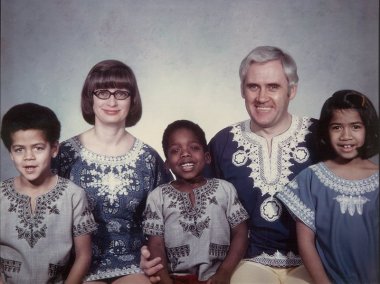
Goller-Sojourner’s parents sent him to a diverse school in a Seattle suburb up until the fifth grade when they were denied their transfer waiver and he went to a new school where he was one of two black kids of color in the fifth grade. “From day one I was racially attacked and that continued for years,” he says. “It only takes one or two people calling you a n—– to stick. The difference is that when a black person is called a racially charged name, they go home and get the love and support from parents who look like them. I went home and got that same love from people who looked just like my tormentors. This was the beginning of trying to figure white people out. Who are the good ones? Who are the bad ones? How do I know?”
Growing up, he was surrounded by white culture. His parents listened to Lawrence Welk during dinner. His mother watched Masterpiece Theater and All My Children. They vacationed in Montana. He doesn’t remember a black person ever being invited into his house.
“What happens when a black kid only has a white identity and then goes out into the world?” he asks. Goller-Sojourner developed tricks for attaching himself to his parents’ whiteness. In stores he would yell out “Hey Mom, can I get this?” when he got sick of feeling watched and followed. When he left for college, he stuck a wallet-sized photo of his Norwegian-American parents behind his identification so cops would see the picture when he was asked to pull out his license on bogus traffic stops. “I’m not the black person you think I am,” he remembers wanting to assert. “I wanted people to know that up front because, one, I didn’t want to die, and, two, this is a weird thing, but transracial adoptees want to put white people at ease.”
It was only when Goller-Sojourner transferred to New York City’s Hunter College that he painfully started building for himself an authentic racial identity. “It was the first time I found my reflection pleasing and I found it reflected back to me in a lot of different ways,” he says. “I was never the only black person in a room again.”
Today Goller-Sojourner wants to spare future generations of adoptees his long winter of self-hatred. Which means when he meets with adoptive parents he shoots down what he sees as a transparent resistance to diversity. “When you transracially adopt you no longer get to use the term ‘good school,’” he says. “That term is meant for white parents with white children, based on good test scores and real estate value. I went to a ‘good school.’ But when your child gets called a n—– you don’t get to call that a good school anymore.
Advocates for diversity at least want adoptive parents to admit it’s often their own anxiety over the very idea that’s stopping them. “If you admit that it would be uncomfortable for you to move, to go to a black church, or do your grocery shopping on the other side of town,” says Goller-Sojourner, “then I say, if somebody is going to be uncomfortable better you than the children.”
Myth 4: You are the hero of your child’s story
There’s an impulse in the adoption conversation to paint the parent as savior—propelled by biblical verse or humanitarian instinct—who swoops in and saves the child. Unfortunately, for this identity to stick, there needs to be someone in need of rescuing. That’s a lousy burden for a child.
In Jane Jeong Trenka’s memoir The Language of Blood, the author describes how the burden of reflexive gratitude can cripple an adoptee’s emotional growth. Neighbors in her all white conservative Minnesota town loved to remind her how very lucky she and her sister were that their German Lutheran parents rescued them from Korea. Her parents called her “chosen,” a verbal tic that made the author feel like a sale item from a department store. Any questions or fantasies about her birth mother seemed like a betrayal of their gift of family. How can one build an authentic relationship of love and trust with a person to whom you’ve been made to feel you owe an unpayable debt? “For the adoptee the imposition of forced gratitude is emotionally crippling,” says Hagland.
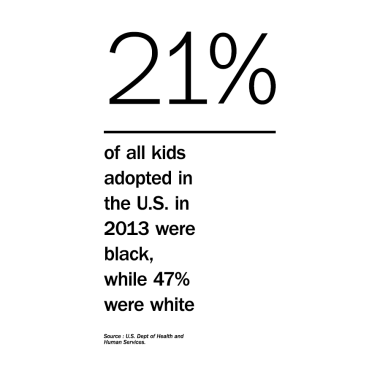
It’s possible that there’s a flip side to this impulse to be a savior. Parents think that if we love our child ferociously enough and do all the right things, we can rescue our beautiful children from a reality we find incomprehensible. We can keep at bay any sense of confusion or discomfort a child of color might feel growing up around a dining room table with family members who don’t know the conspicuousness and vulnerability of being brown in a white world. But what if it’s the wrong fight?
“The concept of the perfect checklist for an adoptive parent is void,” says Joy Lieberthal Rho, a Korean adoptee and social worker with 15 years experience in the adoption field. “There is nothing simple about adoption. If we accept that understanding adoption, race and identity is on a developmental continuum over an adoptee’s entire lifetime, then we see that an adoptee’s work is never done but evolving.”
Rho’s friend and colleague Martha Crawford, a psychotherapist and adoptive mother of two Korean children, agrees. “White adoptive parents are often deeply concerned about being either, one, the only ‘real’ set of parents to their children or, two, worried about doing it right. Both are attempts to ensure that their adopted child won’t experience any challenges related to being a person of color, or related to being an adoptee. This is an absolutely unrealistic and impossible task,” she says. “It is, in my view, an adoptive parent’s job to be a sturdy scaffold for kids to do their own work, not to tell them how to construct their identities.”
Our children’s stories are unique and ever unfolding, messily, beautifully, painfully. A parent can act with agency in crucial ways—change neighborhoods, find mentors, file for school transfers, get steeped in the varied experiences from the ever-growing library of adoptee narratives—but perhaps the adoptive parent’s harder role is simply to bear a humble and compassionate witness. Allow your child her story, whatever it may be.

Alex Landau’s mother Patsy Hathaway believed that love was enough when it came to raising her black son—until her child was severely beaten by Denver police in a routine traffic stop (see story above). “Had I prepared Alex properly, he would have suffered less,” she says today. “I regret this. But he would not have become the leader that he is destined to be either.” Here, Hathaway shares what she wishes she’d known.
1. “Preschoolers experience prejudice. So you teach younger children the best you can [about racism], in simple language. Lessons can become more elaborate as kids mature.”
2. “Children should deeply understand that racism is not their fault; there’s nothing wrong with them. Try to explain without vilifying others.”
3. “Universalize it—white slavery in Greece, the Jewish experience, the struggle that Hispanics face. It’s not just blacks who have suffered; it’s a problem of how people treat each other. You don’t want children to feel that it’s just their race, or who they are.”
4.” Talk about the movement, the wonderful civil rights leaders and how they made a difference. Introduce people your children can identify with and want to emulate.”
5. “When kids are older, parents need to get practical about how to handle potentially dangerous situations like police stops. Make sure they know their rights and that they understand the recommended way to handle themselves with the police. We want our kids to live to become peaceful agents of change.”
Books
Outsiders Within: Writing on Transracial Adoption
Edited by Jane Jeong Trenka, Julia Chinyere Oparah, and Sun Yung Shin
In 30 essays, fiction pieces, and poems, adult adoptees bring their unique perspectives to the psychological ramifications of an institution that’s long only been explored through the narrow lens of the adoptive parent.
The Harris Narratives: An Introspective Study of a Transracial Adoptee
By Susan Harris O’Connor
Originally conceived as autobiographical monologues, the author, a social worker and transracial adoptee, serves up five laser sharp explorations—“My First Birthday” is a winner—of race and identity.
Films

1. Girl, Adopted (2013)
Directed by Melanie Judd and Susan Motamed
A 12-year-old Ethiopian girl leaves her orphanage in Addis Ababa for a new life with a loving and well-meaning family in rural Arkansas. Her sense of isolation and growing self-loathing astounds.
2. American Promise (2013)
Directed by Joe Brewster and Michele Stephenson
Not adoption specific, but a revelatory look at race and education in America. Over 13 years, the filmmakers follow two middle class African American boys and their fraught experiences at New York City’s prestigious prep school Dalton.
3. Off and Running (2010)
Directed by Nicole Opper
An African American girl struggles to feel grounded at home in Brooklyn with her white lesbian parents, older black and Puerto Rican brother and younger Korean brother. A poignant and messy portrait of adolescence.
